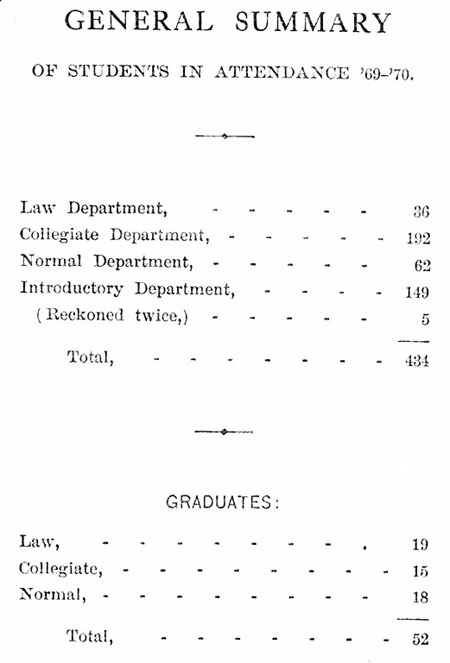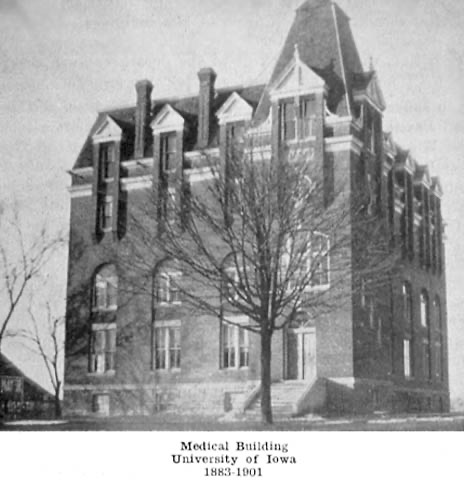Main navigation
Researched and Written by
Dr. Fred Stamler
The legislative edict that all branches of the University be located in Iowa City caused controversy over the Medical College at Keokuk, but it was allowed to continue as the official Medical Department of the University until 1870 when a newly created school at Iowa City became the official Medical Department of the State University of Iowa.
The birth of the new Medical Department was attended by stormy labor pains, and its neonatal life was precarious. Formal efforts to establish the Medical Department were initiated in 1868, when Dr. Washington F. Peck, a Davenport surgeon, met with the University Board of Trustees and presented a complete outline of organization for a proposed Medical Department. A resolution of approval was adopted unanimously by the Board the next day, September 18th. Apparently the Board did nothing to implement the resolution until the following summer, at which time action was taken to provide housing and select faculty for the school.
The opening date for the school was to be not later than the fall of 1870. By this time bitter opposition by factions of the physicians of the State, lead by Dean Hughes of the Keokuk school, had become public. Opposition peaked at the meeting of the State Medical Society in February, 1870. Resolutions passed by the Society were presented to the Governor, and by him to the General Assembly in session, calling for the abolition of the new Medical College. A bill to abolish was passed by the Senate, but failed in the House. A substitute bill was then introduced, giving control of the University to a newly-created Board of Regents, with power to decide the fate of the Medical Department.
This five man Board met for the first time in the spring of 1870, and passed a resolution by a three to two vote, approving the establishment of the Iowa City Medical Department. The Board then made the necessary faculty appointments and gave orders for the school to open not later than the fall of 1870.
Nine faculty positions approved by the Board of Regents included Dr. W.F. Peck as Dean and Professor of Surgery. Dr. Peck was also largely instrumental in selecting the remainder of the appointees, who were to head Departments of Theory and Practice of Medicine, Materia Medica, Physiology and Microscopic Anatomy, Anatomy, Obstetrics, Gynecology, Chemistry, and Medical Jurisprudence. Dr. J.F. Kennedy of Tipton declined the Chair of Obstetrics, and so Dr. J.C. Shrader of Iowa City became Head of a combined department of Obstetrics and Gynecology which has persisted to this day. The faculty received no pay, but medical historians regard them as a competent and conscientious group who did much to enable the infant school to succeed.
The new Medical Department was housed in South Hall, for which an appropriation of $3000 was made in the summer of 1869 for alterations to meet the needs of the new department. This building, located directly south of Old Capitol, was constructed in 1861 as the first campus building designed specifically for University use. The remodeled building included an amphitheater seating over 100 and a basement dissecting room, as well as cabinets and storage facilities for medical supplies and equipment, but it did not provide hospital beds.

The University Catalog 1869-70 announcing the opening of the Medical Department the following term emphasized that Iowa statute decreed that the State University of Iowa should provide educational opportunities to the youth of the State on equal terms to both sexes. The Medical Department, in accord with that liberal policy, would be open on equal terms to youth of both sexes, without regard to color, "and to each will be afforded equal opportunity, and the same facilities for acquiring a complete and thorough medical education". In spite of opposition by some faculty members and others, the College of Medicine thus embarked on a nonsegregated coeducational course which it has maintained throughout its existence.
The first class met on September 20, 1870. The first course consisted of two weeks of preliminary lectures, followed by the regular course of sixteen weeks of medical lectures. There were essentially no requirements for admission, except that candidates for graduation must be twenty-one years of age and of "unexceptional moral character". Candidates for graduation must also have studied medicine for at least three years, including two courses of lectures, submit an acceptable thesis, and pass examinations in all subjects studied. A graduation fee of $25 was assessed, but was returned if the applicant failed the examinations, which may have had a negative effect on failure rates.
The first crisis threatening the new Medical School arose during the first year of operation. The University Catalogue emphasized the role of "Practical Anatomy" in the curriculum, and asserted that "our facilities for obtaining material have been perfected, so that an abundant supply will always be at hand." Evidently logistic imperfections were encountered, however, and a great public outcry arose when it was discovered that a recently interred body had disappeared from a local cemetery. Feelings were intensified when a notebook belonging to the Anatomy Department janitor was found near the desecrated grave. The missing body mysteriously reappeared a night or two later in a casket behind a local mortuary, but did show evidence of partial dissection. At this point, the janitor and the anatomy professor thought it wise to leave town. The State soon took the necessary legal steps to make available for dissection the unclaimed bodies of persons dying in Iowa prisons, and this apparently provided the "abundant supply" of "material" promised by the Medical College prospectus.
The Medical Department at first lacked any sort of hospital, but in 1873 the old Mechanics Academy was converted to hospital use, with the Sisters of Mercy from Davenport supplying housekeeping and nursing care. This building remained in use until 1898 when it was demolished to make way for the first University Hospital, later to be known as East Hall, and now known as Seashore Hall.

The first medical class graduated in the spring of 1871. It included seven women in a class of thirty-eight. Enrollment rapidly escalated, so that within little more than a decade some classes approached 200 in size, and South Hall had become grossly inadequate in size and educational facilities. In 1882 the Legislature granted an appropriation of $30,000 to construct a new medical building beside South Hall, and this building was completed in 1883. The building contained two large amphitheaters, each with capacity to seat 300 to 400 students, a library, and dissection room. A few years later, one of the amphitheaters was altered to provide a small pathology laboratory. Prior to this the only hint of any formal inclusion of pathology in the curriculum was the listing of a museum of morbid anatomy in the yearly University Catalogue.
The medical courses gradually lengthened and evolved through the early years of the Medical College. A two-year course was introduced in 1877 and a three-year course in 1878. In 1879 the catalogue listed both a graded three-year course and an ungraded two-year course. Admission required a high school diploma or successful completion of examinations in English, arithmetic, history, geography, and natural philosophy. Beginning in 1889, only a three-year graded course was offered each year to last six months, and in 1894, the four-year course was instituted.